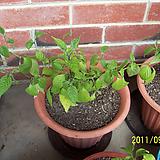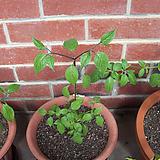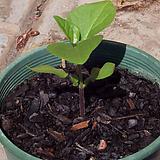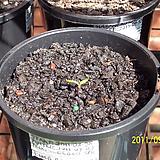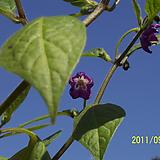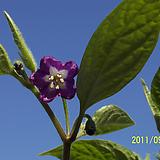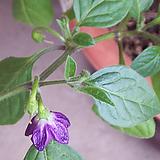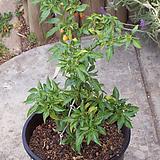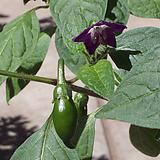Awesome stuff!

Yeah, last season (not this one ending now, the one before) my plants put out for a good time into the cooler months. This year though it seems like they've just had enough and are all giving up now. Some have even started dying.

I'm pretty much ready to cut back now. The small amount of pods still hanging from my plants are pretty much goners anyway so I have nothing to lose. Hopefully at least some of them might bounce back and have much better luck doing their thang next season.
Ah well, c'est la vie, eh?
So what's on your def. grow again list and what's on your def. NOT grow again list?
I've colour coded my list based on my thoughts about the plants at the moment.
Key
Green: Will grow again and replace over wintered plants if needed
Blue: Will keep a some plants over winter but do not plan to replace if they do not survive
Yellow: Potential candidates for the cull
Orange: Likely to be culled
Red: Culled
Season Starts
Capsicum Annuum:
- Acri Sivri
- Ebony Fire
- Fluorescent Purple
- Goat's Weed
- Jalapeño Not Mild
Capsicum Baccatum:
- Aji Amarillo
- Aji Cristal
- Aji Omnicolor
- Bishop's Hat
- Brazilian Starfish
- Not Brazilian Starfish
Capsicum Chinense:
- Beni Highlands #1
- Beni Highlands #2
- Bahamian Goat Pepper
- Biquinho
- Habanero, Chocolate
- Jamaican Hot Chocolate
- Limón (2 sources)
- Morouga Red
- Scotch Bonnet TFM
- Seven Pot (Jonah?)
- Not Habanero Peach
Capsicum Pubescens:
- Manzano, Yellow (cutting)
- Rocoto, Orange
Capsicum mongrel:
- Not Scarlet Lantern
- Not Limo Blanco
- Not Limo Blanco
- Not Bhut Jolokia White (Purple Tinged)
- Not Bhut Jolokia White (Pale Green)
Over wintered plants
Capsicum Annuum:
- Hungarian Hot Wax
- Jalapeño Fire(less) Eater
- Jamaican Yellow
- Rainbow
- Rainbow x Jalapeño Not Mild F1
Capsicum Baccatum:
- Aji Amarillo
- Aji Omnicolor
- Inca Red Drop
- Jalapeño Not Mild
- Not Brazlian Starfish
Capsicum Chinense:
- Bhut Jolokia, Chocolate
- Caribbean Red
- Datil
- Fatalii (Questionable Trueness)
- Habanero, Orange
- Habanero, White (jelly bean shaped, 2 cm max. pod length)
- Maraba Yellow
- Naga Morich (Questionable Trueness)
- Not Seven Pot
- Not Trinidad Scorpion
Capsicum Pubescens:
- Not PI 387838 Locoto #2
- Manzano, Yellow
- Rocoto, Orange
- Not PI 387838 Locato #1
Capsicum mongrels:
I'll round things up in alphabetical order.
Acri Sivri: This is the only C. Annuum that will be replaced next season. It's used in the making of spaghetti meat sauce. These grow well in the garden in clay soil.
I tried these fresh last season and found them to have the C. Annuum flavour with some heat and no noticeable sweetness.
Aji Amarillo: The particular Aji Amarillo variety here grows into a large plant and produces long orange pods. I didn't use the pods this season thus putting it on the endangered varieties list. A drawback of my Aji Amarillo is its large size even in small pots. The one plant remaining is in a 30 cm pot.
I tried these fresh last season and found them to have the C. Baccatum flavour with some heat and no noticeable sweetness nor citrus tone.
Aji Cristal: The Aji Cristal plants scaled better to pot size than some of the other C. Baccatum varieties here. I didn't use the pods much and found them not hot enough for my taste. I'm however curious to see how large the pods would be if a plant was given room to spread its roots. One of the plants in a 3 L pot produced a few large pods that would be well suited to being stuffed with cheese.
Aji Omnicolor: My best Aji Omnicolor was a workhorse of a plant that kept us well stocked with chillies early in the season. It's an attractive plant that does not sprawl outwards and upwards as some of its C. Baccatum cousins. The pods have flavour before they have completely ripened. Once ripe the pods at times have the C. Baccatum flavour plus a citrus type tone. These have been eye catchers amongst the garden.
Gasificada, this may be one to try in a fruitfly infested area to see if you can eat them before they are attacked.
Bahamian Goat Pepper: I only managed to grow one Bahamian Goat Pepper plant from 8 seeds sown. The pods had their own twist on the C. Chinense flavour and a knack for causing all round mouth and throat burn. It scaled down to a 3 L pot well. Thanks to JungleRain for the seeds.
Beni Highlands: I grew two Beni Highlands plants that closely resembled one another until bloom. The first plant to bloom produced many pods without much flower drop. The second plant failed to set a single fruit until a month or so ago. The pods from the good plant had the C. Chinense flavour, sweetness and good heat. It was the first to have this combination in terms of taste. I plan on over wintering the good plant and keeping the other plant around long enough to try the pod. Thanks to JungleRain for the seeds.
Bhut Jolokia Chocolate: The Bhut Jolokia Chocolate has its place as my token Bhut. My sole plant sprawled out with an open and wide habit. I have my eye on an upright branch for cloning purposes. I was able to eat them fresh without too much discomfort. Their main use though was sauce making.
The flavour was more mellow than some of the reds I have tried and not overpowering. The heat of course was scorching hot.
Bhut Jolokia White NOT: I grew two of
Bhut Jolokia White plants from seed and produced two plants with distinct phenotypes from one another. One had purple branches from an early stage plus purple veins on the leaves and is a prolific fruit bearer. The other remained pale green and struggled to produce fruits despite being in the same potting mix and fed the same as the other plants. The pods taste much like the other Capsicum Chinense x Capsicum Annuum mixes I have. Neither plant produced a pod that was cream or white at any stage. This was foreseeable given the questionable photo of depicting the pods where the camera flash was used to white wash out the picture. I have seen the corresponding photo depicting light green pods where the flash was not used that resemble the pods on the paler plant.
Biquinho:
The Biquinho plant was a surprise as I did not expect the seeds to sprout after such a long wait. The plant is doing well and scaled to size in its 1.4 L pot. The pods are mild enough in eat to eat on their own and to my taste have their own twist on the C. Chinense flavour among the varieties I have grown.
Bishop's Hat: I barely used the Bishop's Hat pods this season. The heat of the pods was not close to that of the pods from last season. The overwintered plant produced some rippers last season during the scorching hot weather. The over wintered plant was tall, bushy and needed to be sheltered from the wind to prevent it from being blown over. I don't plant to grow Bishop's Hat plant next season. A plant with pods does make an ornamental gift for those who didn't realise that chillies come in all shapes and sizes.
Brazilian Starfish: My Brazilian Starfish plant grew into a very tall and lanky plant regardless of its pot size. I had hoped it to be a hotter ornamental C. Baccatum then the Bishop's Hat. The pods had the C. Baccatum flavour plus some sweetness but failed to pack a punch heat wise. The plant is in a sheltered spot behind a bush as the wind would otherwise snap it. It holds a place in the garden as the token weird pod shape variety.
Caribbean Red: My sole over wintered Caribbean Red plant went through a long period of flower before becoming loaded up with pods. This is much like the behaviour I observed on a plant in the previous season grown in the ground. I didn't use any of the pods this season. The same plant was a failure in the previous season having produced a mere 3 pods. The flavour in the past season was strong and overpowering when eaten fresh. This is the characteristic that makes it suitable for sauce making. It does not stack up against the other more trouble free C. Chinense varieties I'm growing.
Datil The Datil plant of questionable authenticity turned into a monster after being transplanted from its 3 L pot to an 8 L pot. It was subject to blossom drop and did not produce as many pods as one would expect from its size. It would probably have done better in a larger pot but I feared how big it would become had I transplanted it. The pods had the common C. Chinense flavour, no sweetness and at times a bitter after taste. The flavour brought to question the authenticity of my plant.
Ebony Fire: I have a cluster of Ebony Fire plants in the garden for their ornamental value as black leaved plants. The plants are suited to being an attractive gift for the less chilli crazed person. The pods, though mostly unused, were sweet, hot and meaty. Past plants have had a tendency to produce bitter pods back when I was still searching for a good fertiliser.
Fatalii: The over wintered Fatalii plant was a good performer early in the season. It produced enough pods to make a sauce and serve as a table chilli earlier in the season. This was the sole plant out of a batch of 5 that produced 4 Habanero plants. The pods had the C. Chinense flavour, no citrus tone, no sweetness and a searing heat. The lack of citrus tone and sweetness along with the pods seeming a little too orange brought to question the authenticity of the plant. I failed to sprout Fatalii seeds from two other sources this season.
Fluorescent Purple NOT: The Fluorescent Purple plants I've grown are likely to be some other mislabelled ornamental. The parent plant from which I obtained the seeds survived the winter and grew into a nice bush. The same can not be said for the two plants I neglected by confining them to 1.5 L pots. I never bothered to sample the pods. My original intention was to grow them and give them away as gifts. The Ebony Fire plants come out on top of this ornamental whatever its name may be.
Goat's Weed: The original two Goat's Weed plants grew tall and lanky. These are not suitable for the local climate and suffer from tip die back whenever the temperatures spike and swing. The more tolerant plant lives on through a cutting that has also suffered from tip die-back. The tips have regrown and the plant is recovering. I only ate a few of the pods as I'm not fond of the C. Annuum flavour. The pods were very hot and sweet with a mild C. Annuum flavour. The sole remaining plant is my token fuzzy C. Annuum.
Habanero Chocolate: My sole Habanero Chocolate plant grew into a large plant with thick stems. This was one of the few C. Chinense starts that I transplanted to 8.5 L pots. The plant produced an abundance of large pods with ripping heat plus some sweetness. They go down well roasted stuffed with cheese. The plant out performed the Jamaican Hot Chocolate plants in an unfair comparison as I left the JHC plants in 3 L pots. Thanks to JungleRain for the seeds.
Habanero Orange: My best Habanero Orange plant is compact, bushy and loaded with undersized pods. It took three seasons to finally get a Habanero Orange that did not suffer from long periods of flower drop. I ended up with these plants after growing seeds from a Fatalii pack. The flavour was much like the other two
Habanero Orange varieties I grew in past seasons (United Nurseries 2009, Floriana 2010). I plan on over wintering the two plants.
Habanero White: I transplanted my sole Habanero White plant to the garden where it remained a compact dense small bush. The plant is of variety that produces small jelly bean shaped pods that grew to a maximum of 1.5 cm long. A plant I grew in a past season managed to produce 2 cm long pods. There's some confusion as to the name of the variety as I've seen it referred to as both the Peruvian White and Yucatan White. The pods have the common C. Chinense flavour without any sweetness. The plant doesn't have the vigour to grow spectacularly in the clay based garden soil. I had hoped to replace this with the Limo Blanco this season. The Limo Blanco seeds though grew into a C. Chinense x C. Annuum mongrel. Time will tell of the plant survives its second winter in a less sheltered position.
Hungarian Hot Wax: The remaining Hungarian Hot Wax plant is the parent plant I purchased two seasons ago. I kept it around as it curiously managed to hang on despite remaining in the same pot for some time. I found the pods in the past to have the C. Annuum flavour with a good amount of sweetness. I preferred them right after they changed to orange. My particular strain isn't the most prolific Hungarian Hot Wax out there.
Inca Red Drop: I transplanted my sole remaining over wintered Inca Red Drop plant into the same row as what would become the Habanero White position. The plant had the vigour to grow in a clay based soil and produce more pods than I can count despite less than perfect conditions. It didn't take over the spot in the garden as I suspect some other C. Baccatum would. This one seemed to never miss a beat even during the heat waves. The pods are sweet, have the common C. Baccatum flavour and not much heat to my taste.
Jalapeño Fire(less) Eater: The two Jalapeño Fire(less) Eater plants were started in a previous season from seed harvested from a store bought Floriana Jalapeño Fire Eater plant. I disposed of one plant that had no vigour coming out of winter. The remaining plant once again produced heatless sweet C. Annuum pods. If it survives the winter it will be kept for the heat averse in the household.
Jalapeño Not Mild: The original plant was meant to be a Jalapeño TAM Mild plant. Though it wasn't true to form it did offset the Jalapeño I have coined as Fireless Eater. The supplier also had
regular Jalapeño plants meaning this not turning out to be mild may have been just a label mix up. The plants grown this season are in the same pot as the parent plant. The pods were sweet and had some heat (noting that I am accustomed to much hotter varieties). I culled the plants in the pot down to a couple.
Jamaican Hot Chocolate: The two Jamaican Hot Chocolate plants grew to scale in their 3 L pots either by intrinsic characteristic of via repeat aphid attacks. I didn't make much use of the pods due to spraying for aphids. The plants did produce a good number of pods given the small pot size. The pods I tried didn't hit the heat of the Habanero Chocolate though the potential seems to be there. Thanks to JungleRain for the seeds.
Jamaican Yellow: I retained one of the four Jamaican Yellow plants I started in the previous season. I bought the seeds as Scotch Bonnet seeds but alas found the plants to not even belong to the C. Chinense species. The pods have been used stuffed with cheese and roasted in the oven. The pods have the typical C. Annuum flavour, some sweetness and reasonable heat for an Annuum. The plant performed okay in the garden in a hole filled with a less than perfect growing mix. Alas it is clear that there are suppliers still selling these as Scotch Bonnets.
Limón (C. Chinense): The Limón plants have been the pick of the C. Chinense plants I grew this season. The plants were quick to mature, remained compact and produced many bright yellow pods. These plants handled the hot weather better than other C. Chinense plants. The pods have a citrus like flavour with good heat. The heat was below Habanero level allowing for three or four of them to be eaten fresh with a meal without any discomfort or future discomfort. I haven't come across a bitter Limón pod this season. Thanks to megamoo for providing one source of Limón seeds. The plants were the same as those grown from another source.
Maraba Yellow: I overwintered two Maraba Yellow plants in pots. I transplanted one into the garden next to the Habanero White where it has proven to be a much more vigorous plant than its C. Chinense neighbour. The plant in the garden has produced more pods than I can count. The jelly bean shaped and sized pods have the common C. Chinense and a biting heat with occasional bitter after taste. I had aimed to see if there would be a difference between the two plants in terms of the bitterness issue. It's seemingly a characteristic of the pods when the plants are grown here. Nonetheless it has proven to be one of the tougher C. Chinense varieties I have grown.
Morouga Red: The Morouga Red plant has scaled down to its small pot size. It seemingly also scaled down its production to according to the pot size. I ate 3/4 of the second pod today and was blown away heat wise. It was not unlike a punch in the throat from the vapours from the first bite. It hit hard underneath the tongue. The flavour is more mellow variant on the other red C. Chinense varieties I have tried. Thanks to Pablo_h for trading the seeds.
Manzano Yellow: I rescued this plant from a shop after a heat wave in 2011. It was in a sorry state and defeated all attempts to get it to fruit last season. I managed to get this one to produce fruit this season after a long period of flower drop. The pods that I have tried were very hot and shared the same flavour as my Manzano Orange. The pods were golden yellow though I had hoped for more of a bright canary yellow. This one ranks the lowest among my 3 C. Pubescens varieties.
Naga Morich: The Naga Morich plants did well in their first season for late starts. The plants this season were over wintered from the previous season. There may be question as to whether these are actually Naga Morich plants. The pods I ate fresh in the past were extremely hot given my tolerance at the time. The one plant that I pruned after uprooting at the end of winter produced enough pods to turn into a sauce.
Not PI 387838 Locato: The first Locato to flower among the first plants to produce pods this season. It became apparent some time later that this plant has the benefit of hybrid vigour. The other plant that was more true to form took a longer time to fruit due to various issues. The truer plant tolerates direct sunlight better than the hybrid. It was among the better C. Pubescens plants given it managed to load up with pods in almost 100% shade. The pods have the C. Pubescens flavour and are very hot.
The pods can also have a citrus overtone. I currently have 4 good starts that I will see through the winter.
Rocoto Orange: I over wintered 3 Rocoto Orange plants that had previously produced pods plus a fourth late start that never matured. 3 of the four over wintered plants were hit by issues that resulted in no pods being produced earlier in the season. One plant though did manage to produce pods not long after the Locato hybrid began to produce pods. The oldest plant has recovered from a broken branch and produced a good number of pods in a 45 cm pot. This particular C. Pubescens variety needs more sunlight than the Locato to produce flowers. I sprouted 20 plants from about 20 seeds taken from a spoiled pod of the big plant late last autumn. The first plant to sprout remains in the garden where I transplanted it earlier. It's loaded up with 30+ pods despite various set backs due to the weather. A couple of adjacent plants produced fewer pods. I've concluded that this particular Rocoto is a tricky one to grow given the light requirements in the hot and dry local climate.
Scotch Bonnet TFM: I have six SBTFM plants of which one is a clone of the first plant. I cloned the first plant after something managed to break one of the main branches. I went through a second and third batch of seeds resulting in the last four plants. The second plant that produced two pods with stingers is of particular note. The pods were both had a searing heat that hit in particular underneath the tongue and high on the throat. I could feel the heat bubbling up from my stomach today several hours after eating a pod. The pods I've eaten have almost a citrus tone to them. I plan to keep all six plants. Thanks to JungleRain for the seeds.
Scarlet Lantern, NOT: I decided to sow 12 of the seeds from a pod I took from the plant I disposed. I was curious to see if these would have the same characteristics as the parent plant. The plants resembled the parent plant enough to conclude this one was mixed up with an Annuum some number of generations ago. The supplier still lists this as a C. Chinense Scarlet Lantern. The plant has Annuum characteristics that are also evident in the flavour. I plan to engage in a discussion with the supplier in the hope of pointing out what a true Scarlet Lantern in the future. These plants will likely make way for some winter crops.
Seven Pot (Jonah?): I had an over wintered plant that in hindsight I should have held onto despite the spikey fungus that infested the pot. The now defunct plant only managed to produce one small runt of a pod last season. The one plant I began this season has also been struck by an issue that has restricted it to two bumpy pods that turned from a pale green to red. I need to see and eat more pods before I can judge this one.
I'm not going to review the Trinidad Scorpion Not and Trinidad Seven Pot Not as to do so would not benefit anyone else. They share a common supplier that still has the Trinidad Scorpion on offer but now listed as a Butch T without a change of photos.
In summary the varieties that I suggest are worth considering include:
- Acri Sivri
- Aji Omnicolor
- Bahamian Goat Pepper
- Beni Highlands
- Bhut Jolokia Chocolate
- Biquinho
- Habanero Chocolate
- Habanero Orange
- Limón
Locoto, PI 387838- Morouga Red
- Scotch Bonnet TFM
Updated 31 Aug 2012: Relabelled Locato PI 387838 as Not PI 387838 Locato. Two plants had different characteristics to each other and the pods do not resemble the PI 387838 in shape nor size.
Updated 25 May 2012: Locato PI 387838 pod had a citrus overtone.
Updated 10 May 2012: Biquinho added along with information on how the Acri Sivri, Aji Amarillo and Bhut Jolokia Chocolate tasted.